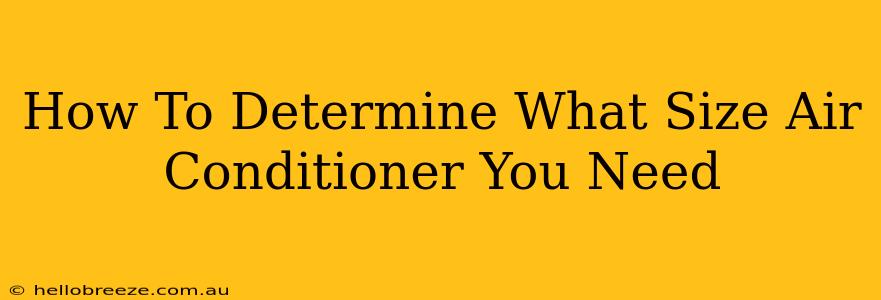Choosing the right air conditioner can significantly impact your comfort and energy bills. An oversized unit will cycle on and off frequently, failing to dehumidify properly and costing you more in the long run. Conversely, an undersized unit will struggle to cool your space effectively, leaving you sweating and uncomfortable. This guide will walk you through determining the correct air conditioner size for your needs.
Understanding BTU Ratings: The Key to Air Conditioner Sizing
The British Thermal Unit (BTU) is the standard measurement for air conditioner capacity. It represents the amount of heat the unit can remove from a space in one hour. A higher BTU rating means a more powerful air conditioner. Finding the right BTU rating is crucial for optimal cooling and energy efficiency.
Factors Affecting BTU Requirements:
Several factors influence the BTU requirement for your space:
-
Room Size: This is the most significant factor. Larger rooms naturally require higher BTU ratings. Measure the length and width of the room to calculate the square footage.
-
Ceiling Height: Higher ceilings require more BTUs to cool the increased volume of air.
-
Number of Windows and Their Orientation: South-facing windows receive more direct sunlight and will require a higher BTU rating to compensate for the added heat gain. The type of window (single-pane vs. double-pane) also matters.
-
Insulation and Window Efficiency: Well-insulated homes with energy-efficient windows will require fewer BTUs than poorly insulated homes.
-
Climate: Hotter climates naturally necessitate air conditioners with higher BTU ratings.
-
Number of Occupants and Appliances: More people and heat-generating appliances (computers, televisions) will increase the cooling load.
-
Desired Cooling Temperature: If you prefer a significantly cooler indoor temperature than the outside temperature, you will need a higher BTU rating.
Calculating Your BTU Requirements:
While online calculators can provide estimates, it's often best to consult a professional HVAC technician for accurate calculations. However, here's a simplified approach:
-
Calculate the room's square footage: Multiply the length by the width of the room.
-
Consider the factors mentioned above: Make adjustments based on the number of windows, insulation quality, climate, and other heat sources. For example, add 10% for each south-facing window, or 15% for poorly insulated walls.
-
Use a BTU calculator (online): Many online BTU calculators are available. Input the calculated square footage and relevant factors to obtain an estimated BTU requirement. Remember that these are estimates; professional assessment is recommended for optimal accuracy.
Don't Forget About SEER Rating!
Beyond BTUs, the Seasonal Energy Efficiency Ratio (SEER) rating is crucial. A higher SEER rating indicates greater energy efficiency. Look for units with a high SEER rating to minimize energy consumption and lower your utility bills. The higher the SEER rating, the more energy-efficient the unit.
Professional Installation Is Key
Once you've determined the appropriate size, professional installation is essential. Proper installation ensures optimal performance, efficiency, and longevity of your air conditioner. A poorly installed unit, regardless of its size, won't function correctly and might even damage your home.
Conclusion:
Determining the right air conditioner size is a crucial step in ensuring your comfort and saving money. While online tools can help, consulting a professional HVAC technician is highly recommended for the most accurate assessment and optimal results. Remember to consider BTU ratings and SEER ratings for both effective cooling and energy efficiency.

